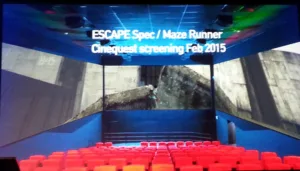Barco’s Escape solution was debuted at last year’s CinemaCon. It features a traditional cinema main screen flanked by two side screens angled at about 110 degrees in the current installations. At TSC, attendees heard more about the development of the platform specifications as well as challenges in content creation.
Dave McKimmie, who was Post Supervisor on the film Maze Runner, started out by describing how they decided to create about 23 seconds of content for the movie in the Escape format as a test. This later turned into about 10 minutes of footage, which was used to officially launch the Escape format in late 2014.
This sequence was first shown in July 2014 with all three screen running 10 bit DPX files from a 7th Sense sever in a Rec 709 color space with UHD resolution. The side screens were white 0.7 gain screens illuminated at 10 FtL to reduce contrast-reducing light cross contamination, while the main screen was a 1.2 gain white screen at 14 FtL.
For the 10 minutes of content, the team turned to a different post house that used a game engine to create the side content as the original approach was way too costly to extend to 10 minutes. McKimmie revealed that the 23 seconds of side footage cost the team about $200K, but the additional content cost about $600K, so had a much better cost/second rate.
The theatrical release was in September 2014, but in Feb. 2015, Barco gave a screening at Cinequest. By now, all three screens were running the content as a DCP in a P3 color space with 14 FtL on each screen. The side screens remained 0.7 gain white, while the main screen was a silver screen.
There are currently five Escape screens, but Barco is targeting to have 25 screens ready by September 2015 for the debut of the Maze Runner sequel. Barco plans to incentivize studios to produce more content in the format once more screens are available.
Under consideration is the idea of a continuous screen instead of three discrete screens with a gap between them. The company is also evaluating the best ways to capture content, i.e. three cameras or one camera to spread to the three screens
In a subsequent panel discussion with Jaunt and Ted Schilowitz and McKimmie, the group was asked if VR could come to theaters? Yes, said Jaunt’s Arthur van Hoff, in a couple of ways. There might be a sequence in a movie for example, where viewers are asked to “put on their headsets” and experience a VR segment. There might also be parlors where you go with your friends to simultaneously experience a movie or other event to obtain a shared experience – almost Matrix like.
Schilowitz, who is Barco’s cinemavangelist and 20th Century Fox’s futurist, agreed saying he knows people who are already working on this in the lab. But not everyone has a VR headset today, so Barco Escape fills a different need for an immersive experience. – Chris Chinnock


